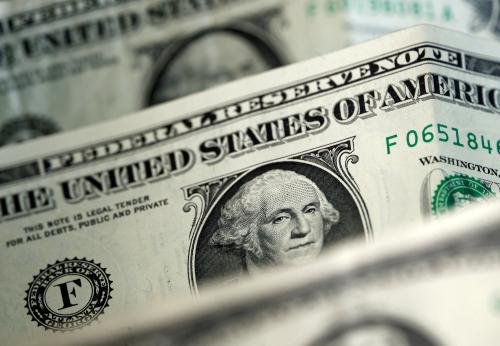Larry Summers has responded to Ben Bernanke’s post about secular stagnation:
Ben Bernanke has inaugurated his blog with a set of thoughtful observations on the determinants of real interest rates (see his post here) and the secular stagnation hypothesis that I have invoked in an effort to understand recent macroeconomic developments. I agree with much of what Ben writes and would highlight in particular his recognition that the Fed is in a sense a follower rather than a leader with respect to real interest rates – since they are determined by broad factors bearing on the supply and demand for capital – and his recognition that equilibrium real rates appear to have been trending downward for quite some time. His challenges to the secular stagnation hypothesis have helped me clarify my thinking and provide an opportunity to address a number of points where I think there has been some confusion in the public debate.
Is Secular Stagnation all about the Zero Lower Bound on Nominal Interest Rates?
The essence of secular stagnation is a chronic excess of saving over investment. The natural question for an economist to ask is how can such a chronic excess exist in flexible markets? In particular, shouldn’t interest rates adjust to equate saving and investment at full employment? The most obvious answer is that short term interest rates can’t fall below zero (or some bound close to zero) and this inhibits full adjustment. Ben is skeptical of the importance of this factor, noting that with a 2 percent inflation target real interest rates can fall to -2 percent. True enough. But, it is at least an open question whether central banks can always be credible in claiming they will hit their inflation targets. Market measures of expected inflation suggest that throughout the industrial world inflation may well fall short of 2 percent for a decade or more.
Separately, it is worth noting that there may be other reasons why interest rate adjustment to equate saving and investment at full employment does not operate smoothly. In situations where target saving is important, reductions in rates may increase rather than decrease saving, exacerbating imbalances. Further, there are reasons for concern that protracted very low rates precipitate financial instability by increasing capitalization ratios, raising the duration of assets, encouraging risk taking to chase yield and reducing the financial discipline associated with loan coupon payments.
Do Real Rates below Zero Make Economic Sense?
Ben suggests not– citing my uncle Paul Samuelson’s famous observation that at a permanently zero or subzero real interest rate it would make sense to invest any amount to level a hill for the resulting saving in transportation costs. Ben grudgingly acknowledges that there are many theoretical mechanisms that could give rise to zero rates. To name a few: credit markets do not work perfectly, property rights are not secure over infinite horizons, property taxes that are explicit or implicit, liquidity service yields on debt, and investors with finite horizons.
To use a phrase Ben has popularized in a different context, negative real rates are phenomenon that we observe in practice if not always in theory. The paper by Hamilton, Harris, Hatzius, and West that he cites demonstrates that during the twentieth century, rates in America have been negative at least 30 percent of the time. In Germany right now, the 10-year nominal rate is 18 basis points suggesting a negative real rate, and the rate is around 60 basis points for 30 years! In Britain, yields on 50-year indexed bonds have been negative for long periods of time.
Were Bubbles an important Contributor to Previous Recoveries?
In support of the idea that the economy suffered from a chronic excess of saving, I have argued that the 2003-2007 recovery and quite possibly the late stages of the 1990s recovery were powered in significant part unsustainable financial conditions. Ben is skeptical, relying on the work of Hamilton et. al (2015) to note that the positive effects of the housing bubble during the previous expansion were offset by an increase in the US trade deficit, and that bubbles were only modestly relevant in the late 1990s. This issue requires much more study. I think that it will be hard to escape the conclusion that household debt grew at an unsustainable pace in the decade before the great financial crisis and that this was an important spur to growth. And I am fairly confident that wealth effects associated with a booming stock market were important in the late 1990s. As I discuss below, I agree with Ben that the open economy aspects are very important and that excess saving in substantial part has emanated from abroad. I have always listed reserve accumulation and foreign demand for safe assets among the major factors acting to depress real interest rates.
How good a solution is expansionary fiscal policy?
Ben accepts the logic of my argument that if reducing rates to equate saving and investment at full employment is infeasible or likely to lead to financial instability, fiscal policy in general and public investment in particular is a natural instrument to promote growth. But he expresses the concern that permanently expansionary fiscal policy may not be possible, given that the government cannot indefinitely expand its debt. This issue is worth further theoretical exploration, but I think Ben greatly understates the scope for feasible fiscal policy for reasons that Brad Delong and I have considered in our 2012 BPEA paper.
Imagine a secular stagnation world with a zero real interest rate. Then, government debt service is very cheap. As long as a public investment project yields any positive return it will generate enough revenue to service the associated debt. This effect will be magnified if there are any Keynesian fiscal stimulus effects of the project or if there are any hysteresis effects. Notice that with sufficiently low real interest rates, even fiscal stimulus, which does not have supply effects, can pay for itself through mulitiplier effects.
This is not just a theoretical point. The October 2014 IMF World Economic Outlook suggests that public investments in countries where interest rates are near the zero lower bound are likely to significantly reduce debt-to-gdp ratios.
The case for expansionary fiscal policy in economies with very low real interest rates is of course magnified if there are reasons to doubt that the central bank can act on its own to raise inflation expectations. It may well be that in situations where the interest rates are trapped near zero – such as those prevailing in Japan and Germany – expansionary fiscal policy reduces real rates by raising inflationary expectations.
What about Global Aspects?
With the benefit of hindsight, I wish I had been clearer in seeking to resurrect the secular stagnation hypothesis that one should take a global perspective. Indeed, the lower level of rates, the greater tendency towards deflation, and inferior output performance in Europe and Japan suggests that the spectre of secular stagnation is greater for them than for the United States. Moreover, in a world with integrated capital markets real rates anywhere will depend on conditions everywhere. Particularly in the 2003-2007 period it is appropriate to regard Ben’s savings glut coming from abroad as an important impediment to demand in the United States. Ben and I are, I think, in agreement that it is important to think about the saving-investment balance not just for countries individually, but for the global economy. If there are more countries tending to have excess saving than there are tending towards excess investment, there will be a global shortage of demand. In this case countries able to devalue their currencies will benefit from generating more demand. Global mechanisms that concentrate on causing borrowing countries to adjust without seeking to shrink the surplus of surplus countries will tend to push the global economy towards contraction.
Successful policy approaches to a global tendency towards excess saving and stagnation will involve not only stimulating public and private investment but will also involve encouraging countries with excess saving to reduce their saving or increase their investment. Policies that seek to stimulate demand through exchange rate changes are a zero-sum game, as demand gained in one place will be lost in another. Secular stagnation and excess foreign saving are best seen alternative ways of describing the same phenomenon.
Final Thoughts
I would like nothing better than to be wrong as Alvin Hansen was with respect to secular stagnation. It may be that growth will soon take hold in the industrial world and allow interest rates and financial conditions to normalize. If so, those like Ben who judged slow recovery to be a reflection of temporary headwinds and misguided fiscal contractions will be vindicated and fears of secular stagnation will have been misplaced.
But throughout the industrial world the vast majority of the revisions in growth forecasts have been downwards for many years now. So, I continue to urge that it is worth taking seriously the possibility that we face a chronic problem of an excess of desired saving relative to investment. If this is the case, monetary policy will not be able to normalize, there will be a continuing need for expanded public and private investment, and there will be a need for global coordination to assure an adequate level of demand and its appropriate distribution. Macroeconomists can contribute by moving beyond their traditional models of business cycles to contemplate the possibility of secular stagnation.
Comments are now closed for this post.
The Brookings Institution is committed to quality, independence, and impact.
We are supported by a diverse array of funders. In line with our values and policies, each Brookings publication represents the sole views of its author(s).











Commentary
On secular stagnation: Larry Summers responds to Ben Bernanke
April 1, 2015